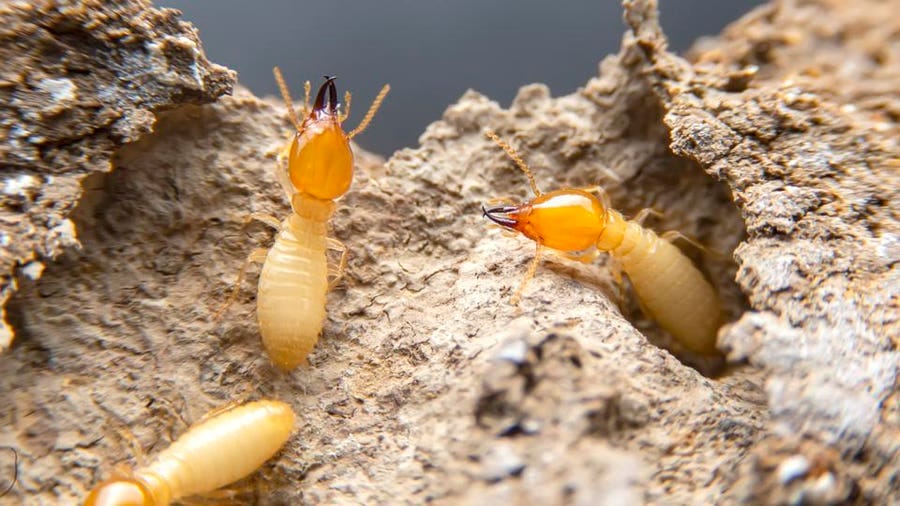Termites, often called silent destroyers, have fascinated entomologists, pest control professionals, and everyday citizens for centuries. These insects play a crucial role in ecosystems by breaking down dead and decaying wood. However, when they invade our homes, they become a formidable threat, causing extensive damage to wooden structures. To better understand termite behavior, we interviewed Dr. Robert Davis, a termite expert from BASF. This article explores the intricate world of termites, exploring their eating habits, colony structure, and more.
Commercial and Residential Pest Control Services | Dodson Bros. Exterminating Co., Inc.
Hallmarks of Termite Behavior
If you want to be prepared to address termite problems, you must understand why they operate the way they do. There are three main markers of termite behavior you should know:
- Termites eat wood.
- Termites are social and live in colonies.
- Termites build unique structures.
Termites Eat Wood
At the core of termite behavior lies their appetite for wood. Termites are cellulose-eating machines, relying on this organic compound found in plant cell walls for sustenance. While they primarily feast on dead and decaying wood in their natural habitat, they become a menace when they target the wooden structures of our homes.
Termites Live in Colonies
One of the most intriguing aspects of termite behavior is their social structure. Unlike solitary insects, termites live in colonies, forming intricate societies with specialized roles for each member, much like the colony structure of bees. The colony functions as a unified entity, working collectively to ensure the survival and prosperity of the community.
Termites Build Structures
The architectural prowess of termites is remarkable. These tiny insects are skilled at building complex structures, such as intricate tunnel systems and nests made of mud tubes. These formations provide shelter, protect against predators, and make it easy for colony members to move about. The ability to build and maintain structures is a testament to the sophisticated organization within termite colonies — not to mention that the structures are a sure-fire way to identify a termite infestation.

The Termite Caste System
One of the most unique things about termites is their highly social nature. A well-defined caste system exists within each termite colony, with each member assigned specific roles based on their physical characteristics and abilities. This caste system allows termite colonies to thrive and expand.
The Termite Queen
At the top of the termite caste system is the queen, the reproductive powerhouse of the colony. The queen’s primary function is to lay eggs, ensuring the continuous growth of the colony. In some species, a queen can lay thousands of eggs per day.
Termite Larvae
The hatched eggs transform into larvae. Larvae undergo several molting stages before reaching maturity and assuming their respective roles within the colony.
Termite Workers
Workers form the majority of the termite colony, tirelessly foraging for food, constructing and repairing structures, and caring for the young. They use pheromones to communicate with one another and accomplish the many jobs they’re tasked with.
Termite Soldiers
Soldiers defend the colony against potential threats and possess powerful jaws and other defense mechanisms. Their primary responsibility is to protect the queen, eggs, and other colony members from predators.
Termite Reproductives
Apart from the queen, reproductive termites, often known as alates or swarmers, play a pivotal role in expanding the colony. These winged termites embark on mating flights, establishing new colonies and perpetuating the termite population.
How Termite Colonies Expand
Like all living organisms, termites require essential resources — shelter, water, and food — for survival. When a termite colony outgrows its current location, it embarks on a strategic and coordinated effort to find a new home, resulting in the start of an infestation.
Typically, during what’s known as swarming season, alates emerge from mature colonies and embark on mating flights. The primary objective of these airborne explorers is to find suitable mates and a promising location for colony foundation. Once a pair of swarmers successfully mates, they shed their wings and form a royal chamber, where the queen begins laying eggs, and eventually, a new colony with its own caste system forms.
Dr. Davis explains the process, “There is a swarming season, and depending on the species of the termite, they have certain times of the year where established colonies that are doing well and have good resources will create extra kings and queens that will have wings on them, and they’ll send them out [to create new colonies].”
To Get Rid of Termites, You Have to Understand Termites — and We Do
At Dodson Pest Control, we understand termite behavior, and we’re well-equipped to address termite problems. If you suspect your home may be invaded by termites, call us. Our team will perform a thorough inspection and develop a treatment plan that’s unique to your situation.
